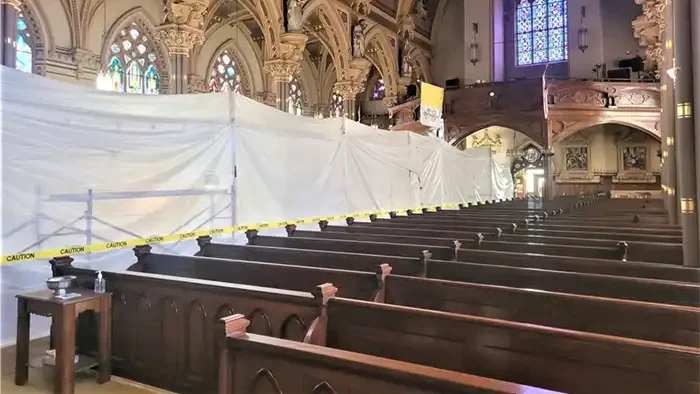
Church restoration has become a useful way for many congregations to recover after a crisis such as a fire or flood, but one man has also uncovered an important aspect of the job that many may not have recognized before.
Jim Egan, who owns Egan Church Furnishing — a Shrewsbury, Massachusetts-based business originally started by his father in 1960 — has experience in church restoration but also in insurance claims. And it was in that field that he began to recognize something important about wood and restoration that he believes many have never noticed.
“I was helping a closed church remove and save their stained-glass windows in a historic church in Manchester, New Hampshire,” Egan said. “The German stained glass was slated for a new church a few miles away.”
Egan explained that the closed church was being renovated for use as a nursing home.
“I noticed the excellent shape the 120-year-old stained-glass frames were in,” he continued. “I had never seen such old frames in such good shape.”
Egan, who has been restoring church furnishings for many years, suggested to church leaders that they remove and preserve the frames as well as the stained glass for the new church.
“A team of engineers and architects examined the frames and agreed with my observation, and the discussion came up on old growth wood,” he said. “I then researched old growth wood.”
Ideal
Old growth wood comes from trees grown naturally in virgin forests and can be over 200 years old. It tends to be ideal for projects that call for a rustic quality to the wood, and it is also very durable and more resistant to rot and warping.
Egan realized from his research that this kind of durable wood is better than any new wood product purchased today. He explained some of what he has been seeing in other churches.
“I just looked at a church that had new mahogany frames installed 17 years ago, and they are already splitting and need repairs,” he commented.
It was Egan’s experience researching old growth wood, restoring historical churches and working in the insurance industry that led him to realize what many pastors and church leaders are missing.
“In my experience with the insurance company that hired me to evaluate a claim on a historic church, when I told the pastor the damaged wood was old growth wood that is 10 times stronger than anything that can be purchased today, the insurance company got upset,” Egan recalled. “It was then I realized most pastors don’t realize the value of their historic churches, and it’s best to preserve the wood frames, pews and moldings.”
Egan has been trying to spread the message wherever he can and hopes to encourage church leaders to preserve their furnishings so that congregations can enjoy them for many years.
“I am finding more pastors willing to keep old pews and restore their frames once we explain they can be restored and are much better than any wood that can be purchased today,” Egan explained.
For more information about old growth wood, church restoration and the services that Egan provides, visit eganchurchfurnishing.com.
Source: thealabamabaptist.org

